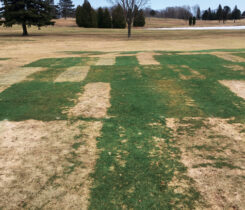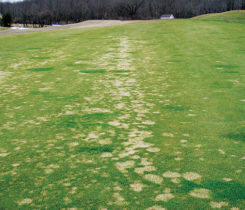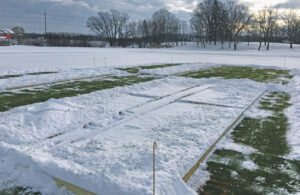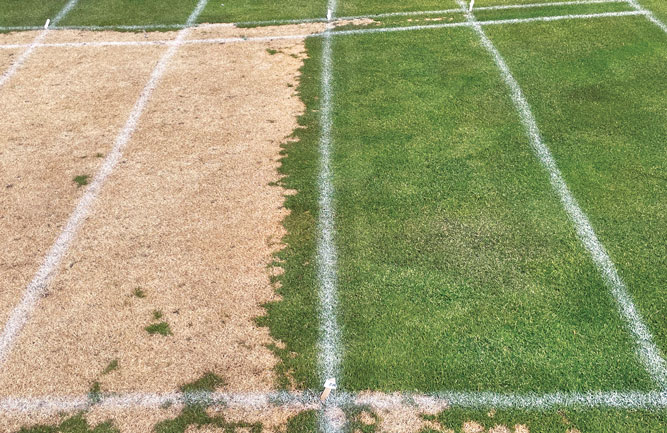Things I learned about snow mold last winter

Figure 1 Nontreated control plots from research sites in Minocqua, Wis., (left) and Marquette, Mich. (right). The snow mold observed in Minocqua was almost all speckled snow mold, while the snow mold observed in Marquette was almost all pink snow mold. (Photo: Paul Koch)
Every winter is different. Some are snowier than others, some are colder than others and some have those dreaded ice events. Sometimes our research plots have lots of snow mold, other years, sadly, none. No matter the conditions, I always manage to learn something about snow mold that I didn’t know the previous year. The main things I learned from last winter are that snow thickness influences which snow mold you experience, the timing of snow onset matters and ice is a crummy insulator. One thing I already knew, but which was reinforced, is that mixing fungicides is crucial for successful snow mold control under heavy disease pressure. Let’s talk about each of these in a little more detail.
Pink, gray or speckled?
First, a quick snow mold review. Pink snow mold is caused by Microdochium nivale, which is the fastest-growing snow mold fungi and able to cause disease in the shortest period of time. If conditions are optimal, M. nivale can cause disease in less than a few weeks. Gray snow mold is caused by Typhula incarnata and is slower growing, requiring roughly 60 days of continuous cover under a deep, insulating snow layer to cause disease. Speckled snow mold is caused by T. ishikariensis and is the slowest growing of them all, requiring about 90 days of continuous snow cover to cause disease.
This past winter, we conducted snow mold research at five sites: two in Madison in southern Wisconsin, a site in Wausau in central Wisconsin, a site in Minocqua in northern Wisconsin and a site in Marquette in Michigan’s Upper Peninsula. The sites in Madison and Wausau normally experience mostly pink snow mold, and the sites in Minocqua and Marquette experience mostly speckled snow mold. However, in 2018-19, Marquette had pink snow mold almost exclusively, despite a snow cover that lasted five months (Figure 1). The site in Minocqua had exclusively speckled snow mold, despite nearly the same duration of snow cover as Marquette (Figure 1).

Figure 2 Surface temperature under the snow cover measured on the research plot in Minocqua, Wis. Deep snow cover provided optimal conditions for snow mold from November through April.
So why pink snow mold for Marquette and speckled snow mold for Minocqua? Luckily, the temperature sensors we installed at the turf surface of every snow mold plot provided a likely explanation.
I mentioned that both sites had snow cover starting in early November and lasting through late April. However, looking at the surface temperature data, it’s clear that the snow cover at Minocqua was deeper throughout the entire winter and provided an ideal growing environment from November through April (Figure 2). On the other hand, the temperatures at Marquette fluctuated wildly from mid-December through mid-January, indicating a thinning of the snow depth, lower ability to insulate and poor conditions for snow mold growth (Figure 3). The snow depth increased in mid-January and provided excellent snow mold conditions from then through April … a period of approximately three months. This period was likely too short for Typhula fungi to cause much damage, and the faster-growing Microdochium took full advantage.
Snow onset timing matters … a lot
In Madison, we have become accustomed to winters that don’t produce a lot of snow mold. Looking back at our research sites over the years, we haven’t had more than 10-percent disease in the nontreated plots in more than a decade. This typically is the result of snow that just doesn’t stick around for more than a few weeks at a time. However, this last winter, Madison experienced well above 60 days of continuous snow cover. This led me to think (and hope) that we finally might see some decent disease at our Madison research site. Alas, when we pulled up to the site in March, we saw no snow mold at all.
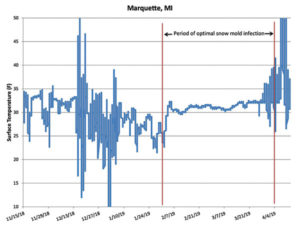
Figure 3 Surface temperature under the snow cover measured on the research plot in Marquette, Mich. A period of relatively shallow snow cover in late December and early January decreased the insulation layer and slowed fungal growth until deeper snow returned in mid-January.
The lack of snow mold almost certainly was due to the timing of snow cover, which didn’t arrive until mid-January. The lack of snow in December and early January allowed for hardening of the turf, and conditions were too cold and dry for fungal growth (Figure 4). Snow mold fungi need temperatures right around freezing and high relative humidity to grow and infect turfgrass, both of which they have under a deep snow cover. However, if those optimal infection conditions don’t come until mid-January — even if they last for two or three months after that — the slow-growing snow mold fungi don’t have the time to rebound, infect the turf and cause disease.
Ice is a crummy insulator
Ice on turf is crummy for many reasons, primarily because it leads to significant winter injury on annual bluegrass and perennial ryegrass. Another reason that I — and probably only I — think ice is crummy, is because it’s a poor insulator. It doesn’t trap heat or moisture well, and as a result, it doesn’t promote snow mold development. Our research site in Wausau had ice cover starting in late December that lasted through mid-April. If this had been snow, it likely would have produced a significant amount of snow mold. But as ice, all it produced was a significant amount of winter injury over the research area.
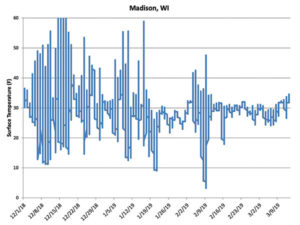
Figure 4 Surface temperature under the snow cover measured on the research plot in Madison, Wis. No snow cover until mid-January resulted in wildly fluctuating surface temperatures in early winter that hampered fungal growth.
More is better for control
This last one isn’t something I learned this year. I’ve been talking about it for years. There are lots of products and product combinations that provide effective snow mold control.
We tested 62 treatments at our Marquette research site last winter, and a whopping 45 of them provided greater than 95-percent disease control. This was a trial where the nontreated controls had more than 80-percent disease. These effective treatments contained all sorts of different combinations, but they all included mixtures of at least three active ingredients from different chemical classes. Products that struggled normally had single active ingredients or were mixtures of two active ingredients. Table 1 shows a small sampling of the most effective treatments in our Marquette experiment. For the full report and the reports and treatment pictures of all our snow mold research from 2018-19, visit our website https://tdl.wisc.edu/results/ and click on the 2018-19 link under “Snow Mold Fungicide Trials.”
Paul Koch, Ph.D., is an assistant professor in the Department of Plant Pathology at the University of Wisconsin-Madison. Please call (608-262-6531) or email Paul (plkoch@wisc.edu) with any questions, comments or concerns.
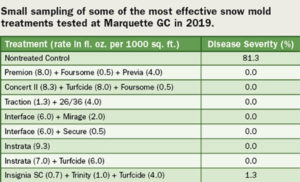
Table 1 For many more effective treatments, the full report can be found at
https://tdl.wisc.edu/results/.
Acknowledgements
None of this work would be possible without the incredible support of our host superintendents. These trials are big and often can take up whole fairways, but the knowledge we gain from them is immense and helps us provide better snow-mold-control recommendations. Thank you to Craig Moore at Marquette GC, Jay Pritzl at Timber Ridge GC, Randy Slavik at Wausau CC and Eric Leonard at Cherokee CC for hosting our trials in 2018-19.









